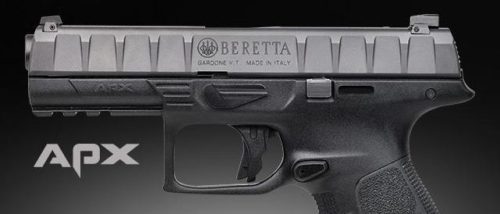
Exciting news: The new Beretta APX pistol was just released for commercial sales in the USA.
There was a lot of talk about the Beretta APX striker-fired pistol at SHOT Show this year. In light of the U.S. Army’s Modular Handgun System (MHS) contract going to the SIG P320, many people wondered what the future would hold for Beretta’s entry.
Beretta’s entry to the MHS, the APX, was the company’s first foray into the full-sized striker-fired pistol market. Frankly, it looks like a winner. I imgaine the competition between it and the SIG was tight.
In great news for consumers, the APX is now available for civilian purchase.
Some may think it is too late for Beretta, but I disagree. Though Glock, HK, and Smith & Wesson have a strong influence in the striker-fired market, the recent additions of the Ruger American Pistol and the MHS winning Sig Sauer P320 clearly show there is still room for competition and innovation in one of the most popular handgun styles today.
Once you’ve read more I think you’ll agree.
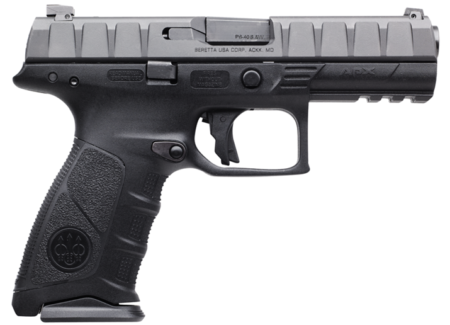
Beretta’s Striker-Fired Pistol
Beretta announced its new APX striker-fired pistol will be shipping to distributors and dealers on April 15, 2017. This is a very important announcement for the company, after what must be a disappointing loss of the U.S. Army’s handgun contract. In fact, though not absolutely confirmed, it has been highly speculated that the APX was Beretta’s submission for the Army’s MHS contract worth $580 million over 10 years.
Despite being late to the striker-fired pistol market, the Beretta APX offers some of the best-to-date features in this category. According to Beretta, the APX was specifically designed for military and law enforcement use, but it is obvious from its design features this pistol will be popular on the civilian market as well. Beretta claims to have put the APX through extremely rigorous testing to ensure its quality, durability and function. This includes a 1 million round testing process, and anthropometric studies (body mechanics) to ensure trigger, action, design, and material reliability.
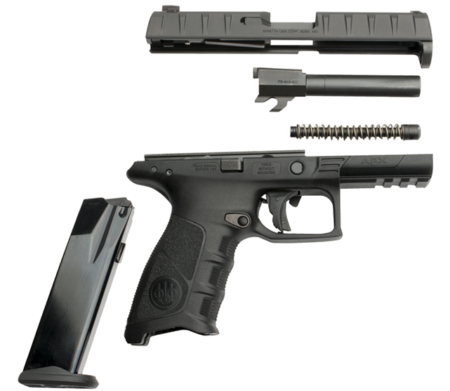
APX Features
- Low bore axis to reduce recoil
- Ideal researched grip angle
- Modular grip frame with interchangeable back-straps (S, M, L)
- Striker deactivator for field stripping
- Aggressive slide serrations front and rear
- Automatic striker block safety and trigger bar safety
- Ambidextrous slide stop lever
- Reversible magazine release lever
- Crisp 6.0-pound trigger pull and quick reset
- Flatter trigger profile for consistent pull
- Dove-tailed 3-dot sights
- Picatinny rail with 3-slots
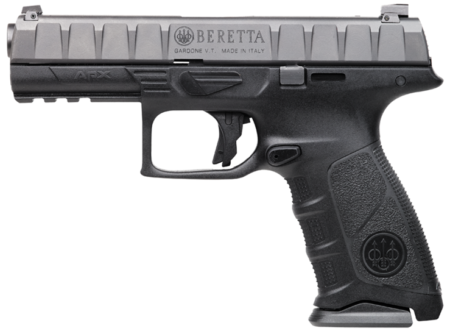
The Beretta APX has what is described as a crisp trigger break at 6-pounds. This is right in the same ballpark as most of the quality striker-fired pistol manufactures and is a good middle-ground trigger pull weight. Too much less, and you enter “hair trigger” territory. Too much more and the trigger becomes laborious and could even induce jerking (misaligned shots) due to the shooter’s effort to simply pull the trigger. The APX has a clear tactile and audible reset that is very short. This provides excellent speed and control for follow-up shots. The trigger is slightly wider than most competitor’s as well.
The APX is designed with a low bore axis. By lowering the bore and slide height, recoil becomes much more manageable, increasing accuracy and follow-up shot ability. This is accomplished by centering the force of the recoil closer to the structure and strength of the frame and the shooter’s grip. Recoil is then directed more backward than in traditional higher bore pistols that send some recoil upward.
To assist in recoil mitigation, Beretta designed the APX with a removable, serialized chassis frame. This is the latest push in striker-fired pistols and a very good one. A solid steel chassis provides a much stronger frame, more capable of handling recoil and ensuring proper ejection and feeding. In addition, by serializing the chassis inside of the frame, the end-buyer no longer has to surrender the entire frame for firearm transfer restrictions or repair work. Only the chassis is considered the “firearm” for BATFE purposes. This also allows modularity in changing calibers, or even frame sizes.
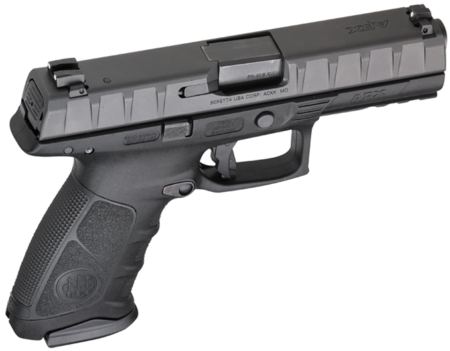
The steel slide and barrel on the APX are black nitride treated for excellent corrosion and rust resistance. The slide has aggressive serrations both front and rear to provide excellent gripping under any circumstance for slide racking or malfunction drills. The rear sight uses a flat front surface area to provide very good gripping surface for non-traditional racking.
Beretta uses a 3-dot white sighting system that is dovetailed into the slide, allowing quick removal and replacement should the shooter desire. This is a huge bonus, as some manufacturers make it very difficult to remove the standard sights. In addition, should there need to be some point of aim (POA) or point of impact (POI) adjustments, a dovetailed design allows for some movement to accommodate individual shooter needs. There are optional Trijicon night sights as well, which I recommend for duty use.

The APX will be highly modular, coming with three replaceable grip frame housings to provide a fit matching the broadest range of shooter’s hands. Disassembly is very simple and includes a striker deactivation pin that allows field stripping without pulling the trigger. Having used a Glock pistol on and off-duty for 17-years, I have to admit that is one of its features I am not thrilled with. It is much safer and user-friendly to be able to disassemble the pistol without pulling the trigger.
In addition, the APX has aggressive texturing on the front and rear of the grip, and a more mild texture on the grip sides. This should provide both a comfortable and secure grip. Beretta does include three mildly shaped finger grooves on the front of the grip, something that is hotly debated both ways. Finger grooves can be beneficial for those whose hands fit them, but highly annoying and detrimental to those whose hands do not fit them.
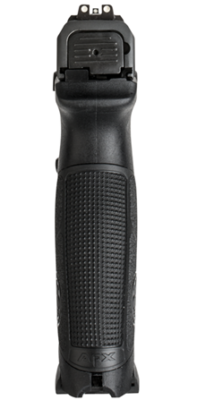
The bottom of the grip is slightly flared at the front to assist with magazine insertion or removal. At the top, there is an enhanced beavertail grip to help reduce felt recoil. The trigger guard is undercut, allowing the shooter to move their hand higher overall on the grip. This provides a much more stable grip platform, which helps control recoil. It also appears the trigger guard is slightly larger, being more forward, than some competitors allowing easier gloved shooting.
To accommodate right or left-handed shooters, the APX’s magazine release button is easily reversible, and the slide stop lever is ambidextrous. These are features that have become more common on new firearms. Manufacturers are realizing the needs of left-handed shooters, and responding to the increase in firearm transitions (strong to off-hand) during competitions and survival shooting drills emphasizing shooting despite an injury to the shooter’s strong side.
Beretta APX magazines also come with a set of beneficial features. Having 17+1 capacity for the 9mm model, and 15+1 capacity for the .40 S&W model, the steel magazines fit flush to the base of the APX frame. However, the magazine base plates are flared out slightly providing excellent gripping platforms for fast and confident magazine changes.
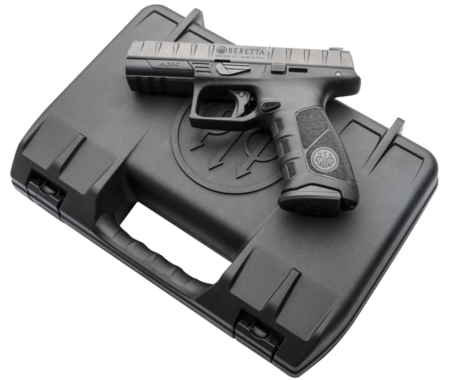
Specifications
- Slide Material: Steel
- Frame Material: Polymer
- Frame Colors: Black, FDE, OD Green, Gray
- Action: Striker fired
- Calibers: 9mm and .40 S&W
- Overall Length: 7.55 inches (Beretta Defense lists 7.56)
- Barrel Length: 4.25 inches
- Height: 5.6 inches
- Weight (Unloaded): 28.24 ounces (9mm); 28.92 ounces (.40 S&W)
- Width: 1.3 inches
- Sights: 3-dot white or optional Trijicon Night Sights
- Capacity: 17+1 (9mm); 15+1 (.40 S&W)
- MSRP: $399 (base model)
Final Thoughts
The Beretta APX is not an earth-shattering new pistol. However, it is a very solid addition to the striker-fired community and a strong delivery from Beretta. What the APX does do, that has not necessarily been seen in the other manufacturer’s striker-fired pistols, is combine almost all of the highly favored design features into one pistol.
From a solid steel serialized chassis to an optimized grip angle and a low bore axis, the Beretta APX was truly designed from top to bottom to provide the shooter a solid and consistent shooting experience. Almost every design feature is more than just window flair, but instead specifically targets areas to improve shooter comfort, grip, accuracy, and shot repeatability. The one exception being the grip finger grooves that will either be praised or condemned.
With an MSRP of just under $600, the Beretta APX will likely see considerable traction in the civilian market. Whether it can claw its way into the law enforcement market, highly dominated by Glock, Smith & Wesson, and Sig Sauer, is yet to be determined.
throwedoff says
You state ” The Beretta APX is their first foray into the striker-fired pistol market, and will be available in the United States starting April 15, 2017.” However, my Beretta Nano is striker fired, and I have owned it for almost three years now.
Aaron E says
Good catch “throwedoff,” I meant to say first “full-size striker-fired pistol market.” It’s been corrected. From all I’ve heard the Nano has been a pretty good pistol for Beretta.
throwedoff says
It is a good weapon. My only complaint is the mile long trigger pull that is extremely heavy. However, I understand the reason for it. As the weapon has no safety other than the trigger blade safety the long heavy trigger pull helps in the accidental/negligent discharge aspect. Unfortunately it makes range work to develop competency with the weapon a real challenge. It will print decent groups, but you really have to work at staging the trigger. It’s also got enough weight in the slide to keep muzzle flip to a minimum. My 12 year old daughter doesn’t mind shooting it. Prefers it to over my Kimber 1911 due to its smaller size.
Aaron E says
That is a true observation – the trigger is unfortunately a long and heavy trigger pull. It’s interesting that so many smaller pistols are similar in that way. Perhaps the thought is a longer, heavier trigger will compensate for potential over-gripping/squeezing on a smaller pistol. Regardless, I’m not a fan.
throwedoff says
I’m not either. It’s funny that my Taurus PT140 has a striker firing system, but a much smoother, lighter, and slightly shorter trigger pull. Well over a thousand rounds through it without any problems other than a few light strikes. Those are remedied with a second pull of the trigger. The ones that weren’t I attributed to the Wolf primers I used in reloading the rounds during the great ammo and reloading component shortage. If the Nano had the PT140’s trigger pull, I would be very pleased with it. However, again I understand the liability reasoning for it.
Aaron E says
Great observations, thanks for the insight!